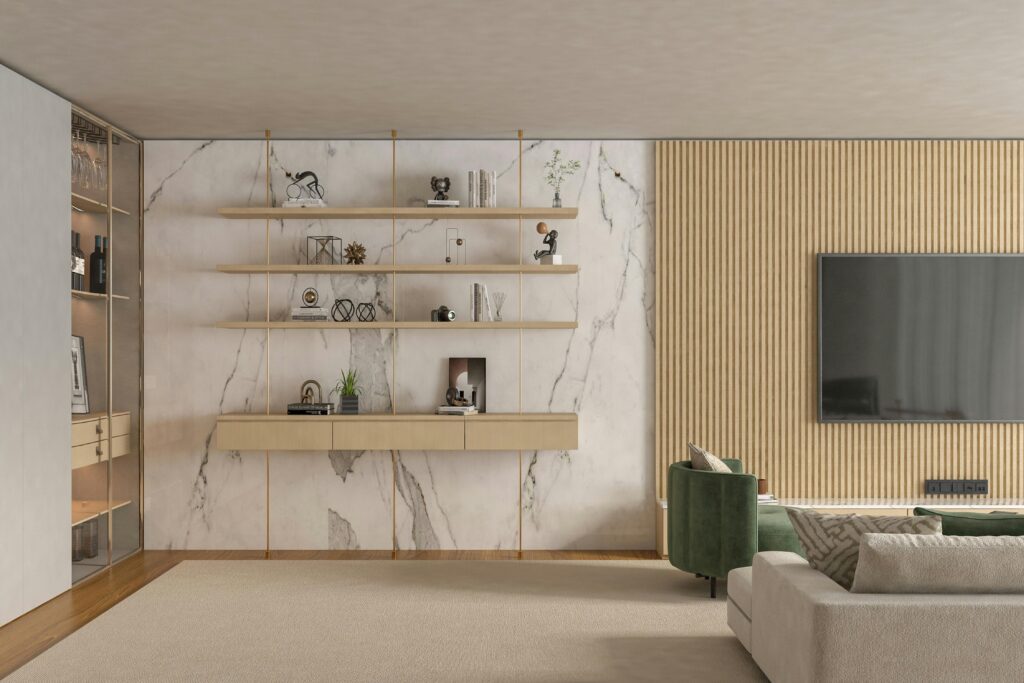The Tiny Details That Make Your Home Feel Cosy
Creating homes, one house at a time.

As interior designers, we’re often asked how to make a home feel more complete.
It’s rarely about buying more furniture or installing bigger features. In fact, the most polished homes usually rely on almost invisible design decisions, the ones you don’t notice, but would miss sorely if they were gone.
If you’ve ever walked into a home and thought it just felt just right, chances are it was shaped by choices that were intentional.
Here are the small details we always look out for, and how they quietly make the biggest difference.
- “Do our lighting choices change with the time of day?”
Why this matters in every home
Most homeowners rely on a single ceiling light to brighten a room. But homes don’t just need brightness. They need atmosphere.
Bright white lights might work for tasks, but they can make a space feel cold or harsh once the sun sets.
What to consider
Use layers of lighting. That means combining ceiling lights with warm wall sconces, pendant lamps, or table lights. Add dimmers where possible so you can soften the mood when needed. The ability to shift your lighting helps the space move with you, from focused work to quiet dinners.
Good lighting doesn’t just help you see better. It helps you feel better in the space.
- “Is there enough breathing room between furniture?”
Why this matters in smaller homes
We often see homes where furniture fits, but just barely. It technically works, but the space feels tight or uncomfortable to walk through. This usually happens when the focus is on filling space, not flowing through it.
What to consider
Leave clear walkways around your key furniture. That means at least 60cm behind a dining chair, enough room to move past the sofa, and space between the bed and the wall. It’s not about how much you can fit. It’s about how easily you can move.
A home should feel easy to navigate – not feel like an obstacle course you have to go through everyday.
- “Are our finishes connected, or competing?”
Why this matters for visual calm
We’ve seen homes where each room feels like it belongs to a different person. Tiles in one pattern, wood in another, doors in a third. None of it’s wrong, but together, it’s visually jarring. When the finishes clash, the home feels louder than it needs to be.
What to consider
Stick to a controlled palette across materials, even if the colours change from room to room. Repeating wood tones, trims, or finishes helps tie everything together. A consistent base gives each room permission to be different without feeling disconnected.
The goal isn’t to match everything. It’s to create quiet continuity.
- “Have we softened the space with texture?”
Why this matters for warmth and comfort
Sometimes, a room feels cold even when the layout and colours are right. The missing ingredient? Texture. It’s the cushions, curtains, rugs, and fabrics that help a space feel lived in, not staged.
What to consider
Use a mix of soft textures in areas you want to relax. Think linen curtains, plush throws, padded headboards, or tactile rugs. In open-plan layouts, texture can also help define zones without building additional walls.
The right textures add depth and warmth. They’re what turn a room into a home.
- “Where do our eyes focus on, and is it intentional?”
Why this matters for flow and focus
In any room, your eyes naturally land somewhere first. If that first impression is a tangle of wires, a cluttered shelf, or an awkward corner, the whole space feels off, even if everything is well-designed.
What to consider
Pay attention to sightlines from the entryway or main seating areas. Use those focal points for simple design moments like a framed print, a tidy console, or a calm window view. Declutter areas that fall directly into view and shift distractions out of frame.
A well-composed sightline helps the whole room feel more put together, even if there’s a mess just outside of it.
A finished home isn’t about more. It’s about intention.
The most cohesive homes aren’t over-designed. They’re just planned with care. They use light, space, material, and flow in quiet but deliberate ways.
If you’re renovating or refining your space, these invisible details are worth considering. Because the things people don’t notice are often the things they remember most.
Thinking of improving your own space? We’re here to help.
📩 Contact us for inquiries: +65 8224 2612
📍 Visit our studio: 625 Aljunied Road Aljunied Industrial Complex #02-02 Singapore – 389836
🌐 Website: janreno.com
📸 Follow us on Instagram: @jan_renovation

Let's Connect
- 625 Aljunied Road Aljunied Industrial Complex #02-02 Singapore - 389836
- +65 8224 2612
- janengineeringpl@gmail.com
- Mon - Sat / 9:00 AM - 6:00 PM
